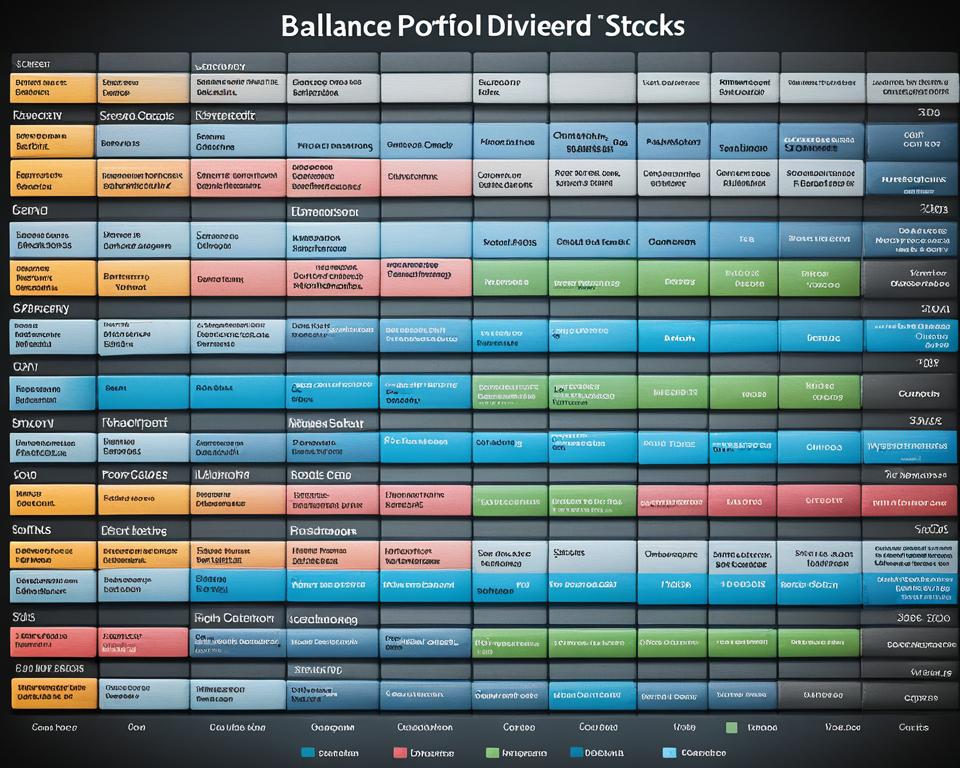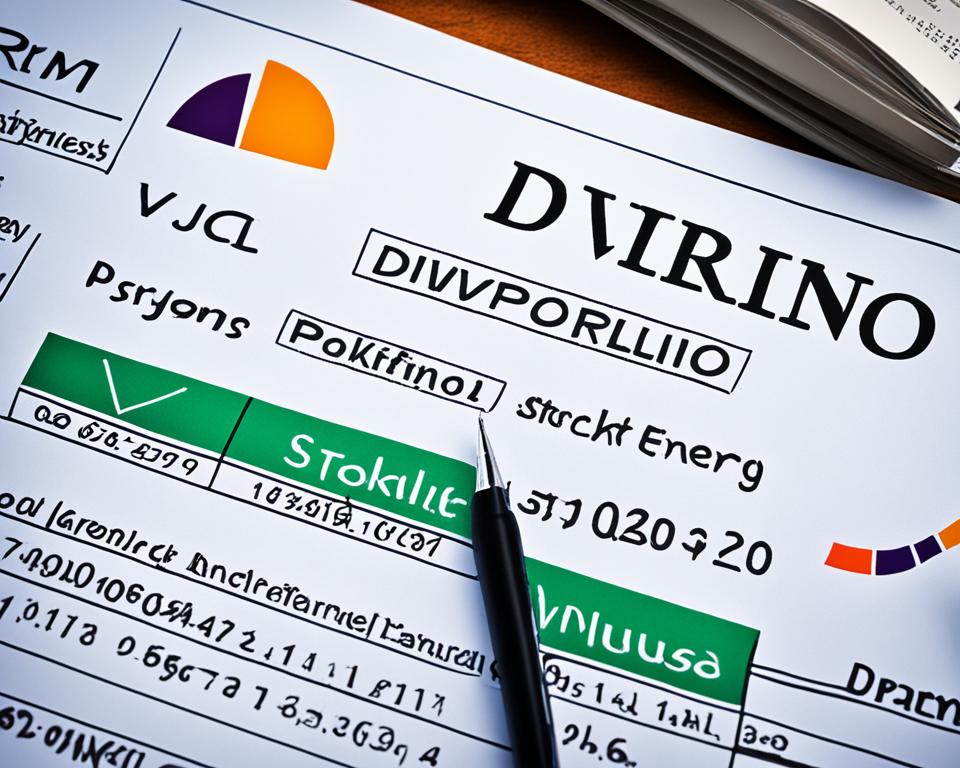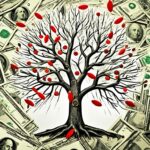Amidst the landscape of investment strategies, dividend investing stands as a beacon for individuals targeting wealth accumulation with an eye on income-focused portfolios. Investors drawn to the allure of high yield dividend stocks are often seeking not just immediate income, but also the promise of growth potential. The quest for the best dividend stocks is a meticulous journey through financial statements and market predictions, requiring a blend of analytical rigor and strategic foresight.
For avid market participants, balancing the search for high yield investments with the necessity for financial health and future viability of businesses becomes key. It’s a financial tightrope walk, where every step – from understanding long-term corporate profitability to navigating the waters of sector trends – counts toward a fruitful dividend yield voyage.
Key Takeaways
- Dividend investing is a strategic approach for those aiming to build a robust, income-generating portfolio.
- Identifying high-yield dividend stocks with sustainable growth necessitates a deep dive into long-term company profitability and sector health.
- One should target businesses with earnings growth prospects within the sweet spot of 5% to 15%.
- Healthy cash flow is the lifeblood of a company’s ability to support and potentially raise dividend payments.
- The timing of stock purchases in relation to the ex-dividend date is crucial to ensure dividend eligibility.
- Avoiding companies with high debt-to-equity ratios is pivotal in protecting dividend investment returns.
Understanding Dividend Investing and Its Advantages
At the heart of a strong dividend portfolio lies the foundational concept of dividend stocks—shares of companies that return a portion of their earnings to investors. These payouts, known as dividends, are a hallmark of corporate strength and a staple in the realm of passive income investing. Such investments not only supply investors with a stream of income but also have the added advantage of offering protection against inflation.
Investors often turn to familiar names like Coca-Cola, which has historically displayed stability and consistent dividends. This stability is critical for those building a passive income-focused portfolio, aiming for regular income streams that also have potential for growth. In a world where economic certainty is hard-fought, dividend investments provide a sense of security and an opportunity to grow wealth over time.
The Basics of Dividend Stocks
A dividend represents a share of a company’s earnings distributed to shareholders, serving as a testament to the company’s financial health and maturity. For individuals focused on passive income investing, these payments give rise to a predictable source of income. Dividend stocks tend to belong to established companies with a proven track record, reflecting a degree of stability that attracts prudent investors.
How Dividends Provide Inflation Protection
Unlike fixed-income securities such as bonds, dividends have an inherent ability to combat inflation. The reason lies in their potential for growth which can outpace inflation rates over time. This makes dividend growth stocks particularly appealing, as companies with growing profits are likely to increase their dividend payouts, thus providing investors with an appreciating income that can safeguard purchasing power in an inflationary environment.
- Dividend portfolios offer a potential hedge against inflation.
- Passive income through dividends can grow over time, unlike fixed bond payments.
- Dividend growth stocks promise an appreciating source of income by capitalizing on company profits.
Gauging Company Health for Sustained Dividend Payments
Investors seeking to bolster their portfolios with stocks that offer sustained dividend payments need to gauge the underlying corporate health and long-term profitability of companies. This deep dive into a company’s financials is akin to checking the pulse of its capability to reward shareholders consistently over time.
Evaluating Long-term Profitability and Cash Flows
Assuring the longevity of dividend payments requires more than a cursory glance at a company’s present success; it requires an assessment of long-term profitability and cash flows. This involves a careful review of earnings reports, to discern the stability and growth potential of a company’s profits. One must look for businesses whose earnings growth is sustainable, ideally within a 5% to 15% range—an indicator of reliable and manageable growth.
A robust stream of cash flow is also paramount in this evaluation. It is the bloodline that funds not only day-to-day operations but also serves as the reservoir from which dividends are paid. Healthy cash flow generation is typically viewed as a good sign that a company can maintain and possibly increase dividend distributions, even in economically turbulent times.
Importance of Dividend-payment Track Records
While long-term profitability and cash flows are staples in evaluating a company’s ability to continue paying dividends, the history of dividend payments cannot be overlooked. A five-year track record of consistent and potentially growing dividend payments can often signify the likelihood of continued payouts. This track record acts as a tangible ledger showcasing a company’s dedication not only to generating profits but to sharing them with shareholders as well.
- Long-term profitability essential for sustainable dividends
- Cash flow generation supports ongoing dividend payments
- Historical dividend track records signal future payment reliability
With these considerations in mind, investors can more effectively pinpoint the companies likely to offer sustained dividend payments, reflecting true corporate health and the capacity for long-term profitability.
Strategic Analysis of High Yield Dividend Stocks
Success in strategic investment hinges on identifying opportunities that not only provide direct income through dividends but also possess long-term growth potential. A thorough high yield dividend stocks analysis sets the foundation for investors aiming to build a profitable and sound portfolio. The cornerstone of such an analysis encompasses reviewing earnings growth, scrutinizing cash flow statements, and evaluating debt levels—each an integral metric affecting a company’s ability to pay and sustain dividends.

When considering high yield dividend stocks, it is imperative to delve into each company’s financial performance meticulously. The analysis should extend beyond simple dividend yield figures to include a comprehensive exploration of a company’s history and prospects. Each company should be evaluated based on several criteria that collectively signify its stability and future outlook.
| Earnings Growth Expectations | Cash Flow Generation | Debt-to-Equity Ratio | Dividend Track Record |
|---|---|---|---|
| 5% to 15% range is optimal for stable, sustainable growth. | Indicates the company’s ability to finance dividends without external borrowing. | Ratios above 2.00 suggest a high degree of leverage which could impede future dividend payments. | At least a five-year history of consistent dividends is a promising sign. |
To align with a strategic investment approach, it’s not enough to look at present profitability. Investors must project how a business will fare in the future—itsanticipated earnings growth paints a vivid picture of its capability to raise dividend payments steadily over time. Monitoring a company’s cash flow is equally revealing; strong cash flow signals the company’s ability to maintain its dividend policy even when external conditions fluctuate. Additionally, analyzing how a business utilizes its capital is crucial. A stable debt-to-equity ratio often translates to financial resilience and sustainability, which cornerstones for long-term dividend growth.
High yield dividend stocks analysis is a fine-tuned process reaffirming that dividends are more than a mere reflection of current profitability—they are also a proactive commitment to returning value to shareholders consistently over time. Identifying high yield dividends with these strategic insights promises a balanced portfolio that can endure market variations while providing a steady income stream.
Identifying Dividend Growth Stocks with Strong Fundamentals
For investors seeking avenues of stable and growing passive income, the attraction to dividend growth stocks with strong fundamentals is undeniable. These stocks promise not just regular dividend payments but also the potential for capital appreciation, thanks to their earnings growth. However, understanding and identifying such gems requires a thorough analysis of a company’s financial indicators.
Before delving into specific financial metrics, one must comprehend the critical nature of earnings growth and cash flows in corroborating a company’s ability to provide continual and increasing dividends—a trait of the most robust investment options in this domain.
The Significance of Earnings Growth Expectations
Earnings growth expectations serve as a litmus test for the company’s future profitability and, by extension, its ability to increase dividend payouts. Notably, companies that are anticipated to grow earnings between 5% and 15% offer a harmonious balance of stability and expansion; they are typically robust enough to continue rewarding shareholders while still capturing market opportunities for further development.
| Company | Average Earnings Growth (5 Yrs) | Projected Earnings Growth (Next Yr) | Dividend Yield |
|---|---|---|---|
| Company A | 7% | 6% | 3.5% |
| Company B | 12% | 10% | 2.8% |
| Company C | 4% | 5% | 4.2% |
| S&P 500 Average | 8% | 9% | 1.8% |
A critical aspect here is sustainability. While high growth can be alluring, those exceeding the 15% threshold often find it more challenging to maintain such momentum, possibly leading to earnings disappointments and subsequent adverse effects on stock prices and dividend reliability.
Why Strong Cash Flow Generation Matters
Cash is undeniably king in the context of supporting ongoing dividend payments and fueling their growth. A company demonstrating strong cash flow generation is often well-positioned to sustain its dividend distributions, even in the face of economic headwinds. Investors would be well-advised to examine free cash flow figures intently, as this metric accentuates a company’s true financial flexibility and its capacity to channel profits back to shareholders.
“Consider the ability to generate healthy cash flow as the financial backbone of any dividend-paying enterprise. It signifies not just current fiscal health but also conveys a resilience to endure and evolve amidst market fluctuations.”
Finding dividend growth stocks with strong fundamentals is like piecing together a financial puzzle. By focusing on earnings growth and persistent cash flows, investors lay the groundwork for a portfolio that can potentially provide both security and growth—a financial duality sought by the astute dividend investor.
Navigating the Risks: Avoiding High Debt-to-Equity Ratios
When seeking high yield investments, astute investors know that managing investment risks is paramount for sustained success. An essential aspect of risk management is paying close attention to a company’s financial leverage, particularly its debt-to-equity ratio. This ratio is a barometer of a company’s financial health and its capacity to continue delivering dividends to shareholders.
Indeed, finding a promising high-yield stock can be exhilarating, yet one must tread cautiously when debt enters the equation. A high debt-to-equity ratio, especially those figures exceeding the threshold of 2.00, can serve as a forewarning: the company may be overly reliant on debt financing. Such a fiscal situation necessitates that future profits be allocated toward debt repayment, potentially undermining the funds available for dividend distribution.
In the intricate balancing act of high yield investments, the imperative shifts to seeking companies that are not just profitable but also prudently leveraged. It is not merely a matter of avoiding those with excessive debt but selecting firms that demonstrate a judicious use of leverage as a tool for growth without compromising their dividend commitments.
- High debt levels can signal potential future dividend risk.
- Prudent debt management is key for sustainable high yield dividends.
- Investors should prioritize companies with lower, manageable debt-to-equity ratios.
Knowing which companies to avoid is as crucial as identifying which to include in your portfolio. To illustrate this, consider the following table comparing various companies’ debt-to-equity ratios and their implications for dividend reliability:
| Company | Industry | Debt-to-Equity Ratio | Dividend Yield |
|---|---|---|---|
| Company 1 | Technology | 1.25 | 2.5% |
| Company 2 | Healthcare | 2.10 | 3.8% |
| Company 3 | Consumer Goods | 0.80 | 4.0% |
A discerning investor might choose Company 3 from the above table, noting its modest leverage and attractive dividend. On the other hand, Company 2, despite a higher yield, carries a weighty debt-to-equity ratio, which raises concerns about the viability and growth of its dividends. This careful selection underscores the importance of managing investment risks by avoiding highly leveraged companies.
As investors navigate the complex waters of dividend investments, being vigilant about leverage ratios is a prudent strategy that can guard against the erosive effects of excessive debt, thereby ensuring dividends add value to a portfolio rather than cause unexpected financial strain.
Monitoring Ex-Dividend Dates for Timely Investments
To harness the benefits of dividend stocks, savvy investors meticulously track the ex-dividend date to ensure they are eligible for the upcoming dividend payout. The ex-dividend date is a pivotal marker in the timeline of a dividend-paying stock, signifying the cut-off point for shareholders to qualify for the next scheduled dividend. Understanding and acting on this date is integral for those who aim for timely investments within their dividend investing strategy.

How the Ex-Dividend Date Affects Dividend Eligibility
The significance of the ex-dividend date cannot be overstated—it is the determining factor for dividend eligibility. To be eligible for a dividend, an investor must be on the company’s books as a shareholder prior to the ex-dividend date. This date is typically set two business days before the record date, which is the actual cutoff date used to determine to whom the dividend will be paid. Failure to own the stock before the ex-dividend date means the investor will miss out on that dividend payment, making it imperative to plan transactions around this window.
Here’s an example scenario to emphasize this critical timing:
- ABC Corporation declares a dividend with an ex-dividend date of April 15th.
- To receive this dividend, an investor must purchase ABC Corporation’s stock before April 15th.
- Investments made on or after April 15th will not be eligible for the just-declared dividend.
Incorporating the ex-dividend date into your investment strategy means prioritizing the acquisition of shares within a timeframe that guarantees your stake in the dividend. Making timely investments by buying before the ex-dividend date is as critical as selecting the right dividend-paying stock. By consistently tracking this date, investors can optimize the income-generating potential of their portfolios.
Understanding the Role of Sector Trends in Dividend Viability
While individual company performance is a crucial factor in assessing dividend-paying stock potential, sector trends provide invaluable context for making informed investment decisions. These trends can offer foresight into the economic conditions and consumer behaviors that may influence a company’s ability to sustain and grow its dividends over time.
Assessing Sector Performance and Economic Indicators
Dividend viability is deeply intertwined with sector performance, as industries react differently to various economic indicators. By analyzing the state of the economy and looking closely at the performance of key sectors, investors can predict which companies are likely to maintain their dividends. Data on market trends, unemployment rates, and GDP growth serve as harbingers for investors, guiding them to sectors that show resilience or growth potential in changing economic climates.
Projecting Future Growth Based on Consumer and Industry Trends
The alignment of company prospects with overarching consumer trends and industry developments is also essential for the long-term viability of dividend payouts. For instance, demographic shifts leading to increased healthcare demands can favor companies within that sector. Conversely, emerging trends towards healthier lifestyles may impact consumer staples sectors, such as beverage companies adapting their product lines to stay relevant. Projecting future growth based on these patterns is integral for identifying dividend stocks capable of adapting to evolving consumer preferences.
| Sector | Key Economic Indicator | Consumer Trend Impact | Projected Dividend Growth |
|---|---|---|---|
| Healthcare | Population aging | Growing demand for medical services | Potential for stable to increased dividends |
| Consumer Staples | Consumer confidence index | Shift towards organic products | Yields may fluctuate with adaptation to trends |
| Technology | Research and development investment | Innovation and consumer adoption rates | Volatility with high growth prospects |
| Energy | Oil price trends | Transition to renewable sources | Dividends could dip with sector transformation |
A thorough understanding of sector trends and their interfacing with economic and consumer dynamics offers a compass to navigate the dividend investment landscape. Investors keen on realizing the full potential of their dividend stocks must parse through these layers of economic storytelling to unearth the stocks primed for sustainable growth and robust dividends.
The Impact of Dividend Yields on Investment Decisions
For the investor eying long-term gains, dividend yields are more than just figures on a financial statement; they are pivotal indicators that guide investment decisions. The yield, determined by dividing the annual dividend payouts by the current share price, offers a lens through which the financial attractiveness of a stock can be evaluated. Yet, the savvy investor looks deeper, discerning the implications behind the numbers—a crucial exercise in strategic investment.
One essential aspect to scrutinize is whether a dividend’s attractiveness is owed to a rising share price, a positive sign synonymous with a company’s growth and solid financial health, or to a falling share price that can foreshadow potential dividend cuts. It’s the difference between riding a wave to shore and being caught in a receding tide.
| Company | Annual Dividend Payout | Current Share Price | Dividend Yield | Growth Outlook |
|---|---|---|---|---|
| Company X | $2.00 | $40 | 5% | Stable |
| Company Y | $1.00 | $10 | 10% | Declining Share Price |
| Company Z | $2.50 | $100 | 2.5% | Rising Share Price |
“Investors should approach high dividend yields with a discerning eye; evaluating whether they are a sign of sustained company performance or a potential red flag requiring deeper analysis.”
Regarding dividend yields, context is king. Yields should be compared over time and against industry averages for a clear perspective. Sustainable growth often accompanies higher yields resulting from increased profits, whereas yields inflated by declining share prices warrant a cautious approach. Such critical analyses are quintessential in shaping sound investment decisions that stand the test of market volatility.
The calculation and implications of dividend yields play an indispensable role in assessing a stock’s attractiveness and how it fits within a broader investment strategy. By diligent examination of this key metric, investors can align their portfolio with stocks that represent both stability and an opportunity for capital appreciation, ensuring their investment decisions are balanced, informed, and poised for growth.
Building a Balanced Dividend Portfolio
Achieving financial equilibrium within a dividend-centric investment approach is predicated on establishing a balanced dividend portfolio. Such a portfolio marries the allure of high-yielding stocks with the promise of dividend growth equities. Crafting this balance is pivotal for those intently focused on utilizing allocation strategies to optimize returns and minimize potential risks engendered by market fluctuations and specific stock vulnerabilities.

Combining High Yielding and Dividend Growth Stocks
To curate a balanced dividend portfolio, investors must weave together both high-yielding and growth-centric dividend stocks. High yielding stocks often act as the workhorses in producing steady income, whilst dividend growth stocks serve as torchbearers for capital appreciation. This tandem addresses the two-pronged goal of generating reliable income and fostering portfolio growth.
Take, for example, a company like Coca-Cola, revered for its steady dividend and moderate growth, it can serve as a bastion of stability within a diversified portfolio, balancing out the risker high-growth segments. Conversely, integrating stocks from sectors like technology—which may offer lower initial yields but hold higher growth potential—promises a blend that captures a spectrum of income and growth across different sectors and economic cycles.
Allocation Strategies to Optimize Returns
Optimal allocation strategies pivot on diversification, not just across industries but also regarding the yield-to-growth ratio within the dividend domain. Seasoned investors distribute their assets among a variety of dividend payers, safeguarding against the possibility of any one sector or company’s dividend cut affecting the overall returns of their portfolio.
Moreover, the art of allocation extends to matching personal investment timelines with dividend disbursements. For instance, retirees may prioritize high-yielding stocks for immediate income, whereas long-term investors might lean towards growth-oriented dividends, betting on their ascendant value over time.
| Stock Type | Yield Characteristics | Growth Potential | Recommended Allocation |
|---|---|---|---|
| High Yielding | Higher immediate dividends, lower growth rates | Lower | Larger share for income-focused investors |
| Growth-Oriented | Lower initial dividends, higher growth rates | Higher | Larger share for long-term growth investors |
| Mixed Allocation | Blend of immediate yields and growth prospects | Moderate to High | Varies based on investor goals and risk tolerance |
By meticulously selecting an array of dividend-dispensing entities, investors establish a robust structure capable of withstanding economic headwinds while still achieving their financial aspirations. In essence, a balanced dividend portfolio is not a fixed model but a dynamic canvas, perennially adjusted and fine-tuned through strategic allocation to meet the evolving goals of the investor and respond adeptly to the caprices of the market.
Reinvestment Strategies for Maximizing Total Returns
The practice of reinvestment strategies serves as a powerful tool for investors looking to compound the growth of their portfolios. By choosing dividend reinvestment, the potential to enhance one’s total returns over the long term becomes a tangible opportunity. This act of automatically funneling dividends back into additional shares of the issuing company can significantly amplify the value of an investment, leveraging the power of compounding to potentially double returns when compared to scenarios where dividends are not reinvested.
While reinvestment is typically a prudent approach to grow wealth, certain circumstances such as approaching retirement or rebalancing a diversified portfolio might necessitate a strategic deployment of dividend gains into other financial avenues. Those nearing retirement may benefit from channeling dividend income into more liquid assets to support living expenses, illustrating the importance of personalizing reinvestment strategies to suit distinct financial objectives.
The path to maximizing total returns through dividends is not linear and demands a consideration of individual market positions, financial goals, and the timing of cash flow requirements. Here is an illustrative table detailing different reinvestment strategies and their potential impact on an investor’s financial growth:
| Strategy | Benefits | Considerations | Ideal for Investor Type |
|---|---|---|---|
| Full Dividend Reinvestment | Accelerated compounding, potential for doubling investment over time | Reduces immediate cash income for investor | Long-term growth-focused investors |
| Partial Dividend Reinvestment | Balance between growth and cash income | Slower compounding effect compared to full reinvestment | Investors seeking moderate growth and income |
| Dividend Income Strategy | Provides regular cash flow | Misses out on compounding benefits | Retirees or income-dependent investors |
As an integral component of a strategic asset allocation plan, understanding and utilizing dividend reinvestment can prove to be a substantial influence on the trajectory of an investor’s portfolio gains. Consistently applied, reinvestment strategies can transform modest dividend distributions into sizable contributions to an investor’s total wealth accumulation.
In sum, whether an investor opts for immediate income or long-term compounding, the careful tailoring of reinvestment strategies to align with personal financial goals is a crucial consideration in maximizing the potential for total returns and achieving a secure financial future.
Tax Implications of Dividend Earnings
Dividend earnings entice investors with the promise of steady income, but understanding their tax implications is crucial. Investors navigating the dividend terrain must acquaint themselves with tax rates applicable to their earnings, aptly categorized as either qualified or non-qualified dividends. This distinction bears significant tax consequences and plays an essential role in managing the fiscal aspects of an investment portfolio.
Distinguishing Between Qualified and Non-Qualified Dividends
Qualified dividends are coveted by investors for their favorable tax treatment. Typically, these are dividends paid by U.S. corporations or qualified foreign entities, meeting specific holding period requirements. The tax implications of receiving qualified dividends are substantial, as they are taxed at the more lenient capital gains rates of 0%, 15%, or 20%. This preferential rate hinges on the investor’s overall taxable income and filing status, often resulting in significant tax savings.
In contrast, non-qualified dividends are taxed as ordinary income. These dividends do not meet the criteria for qualified status and are subject to the individual’s income tax bracket, potentially reaching up to 37% for high-earners. Often, dividends from certain investments, such as those paid by real estate investment trusts (REITs) or master limited partnerships (MLPs), fall into this category.
Reporting Dividends on Your Tax Return
When it’s time to report dividend income, the Internal Revenue Service (IRS) necessitates a detailed account of all dividends received throughout the year. Investors receive IRS Form 1099-DIV, Dividends and Distributions, which enumerates the dividends earned, distinguishing between qualified and non-qualified amounts. Every investor must then notate this information onto their Form 1040, with the sum total of qualified dividends entered on Line 3a and the ordinary dividends on Line 3b.
Reporting dividends accurately is of paramount importance. It not only ensures compliance with tax laws but also allows taxpayers to take full advantage of the lower tax rates available for qualified dividends. Failure to accurately report dividends can result in penalties, underpayment, or an unwelcome audit by the IRS. With this in mind, investors must remain vigilant in their reporting practices, maintaining meticulous records of their dividend earnings throughout the year.
| Dividend Type | Tax Rate | Form for Reporting | IRS Form Line |
|---|---|---|---|
| Qualified Dividends | 0%, 15%, or 20% | Form 1040, Form 1099-DIV | Line 3a |
| Non-Qualified Dividends | Ordinary Income Rate | Form 1040, Form 1099-DIV | Line 3b |
Investors must not only identify which dividends qualify for reduced tax rates but also strategically plan their portfolios with these tax implications in mind. Allocating investments towards assets that yield qualified dividends can optimize after-tax returns and contribute to an overall more efficient investment strategy.
Examining Dividends as a Reflection of Company Stability
Dividends serve as a vital indicator of a company’s stability, mirroring its financial health and operational success. Established corporations often distribute dividends to signal confidence in their profitability and to share the fruits of success with shareholders. The reliability of these payments, made possible by sustained business performance, illustrates the company’s ability to maintain its financial commitments over time. The regularity and size of dividend payouts are thus often perceived as a dividend reflection of a company’s resilience and its management’s stewardship.
However, an exceptionally high dividend yield can sometimes flag potential concerns. Instead of reflecting a company’s strong performance, it may suggest limited opportunities for reinvestment back into the business. High yields might also indicate that management is attempting to appease shareholders during times of stagnant stock growth. In such cases, the dividend can be a double-edged sword—a short-term reward that might undermine a company’s capacity for long-term growth and sustainability.
Therefore, it is crucial for investors to peer beneath the surface of attractive dividend offerings. Beyond their initial appeal, they should evaluate the broader strategies employed by the company, including how dividends are funded and whether they align with long-term growth plans. A company’s judicious use of dividend strategies reflects a balanced approach to rewarding investors while simultaneously fueling future expansion and innovation.
FAQ
How can investors identify high-yield dividend stocks with strong growth potential?
Investors can identify high yield dividend stocks with strong growth potential by looking for companies with long-term profitability, earnings growth expectations between 5% and 15%, robust cash flow to support dividends, debt-to-equity ratios below 2.00, and a track record of consistent dividend payouts. Analyzing broader sector trends can also indicate whether a company can thrive in the future.
What are the basics of dividend stocks?
Dividend stocks are shares of companies that pay out a portion of their earnings to shareholders, usually on a quarterly basis. These payments are known as dividends and are considered a sign of a company’s financial health and maturity. Dividend investing is often pursued by those looking to create an income-focused portfolio for passive income or retirement planning.
How do dividends provide inflation protection?
Dividends provide inflation protection by offering a potential source of increasing income over time, unlike fixed returns from bonds that can lose purchasing power due to inflation. Many dividend growth stocks aim to increase their payouts over time, potentially outpacing the rate of inflation, thus preserving the investor’s purchasing power.
How can an investor evaluate a company’s long-term profitability and cash flows for sustained dividend payments?
To evaluate a company’s long-term profitability, investors should review financial statements for consistent revenue and earnings growth. Healthy cash flow generation is also critical, as it indicates a firm’s ability to maintain and potentially grow dividends. Looking at the company’s dividend-payment track record is another way to assess its capacity to sustain dividend payments.
Why is it important to look at a company’s dividend-payment track record?
A company’s dividend-payment track record is crucial because it indicates the reliability and stability of dividends. A consistent history of paying and increasing dividends over the years suggests strong financial health and management’s commitment to shareholders, which often points to a strong likelihood of continued dividend payments.
What constitutes strategic investment in high yield dividend stocks?
Strategic investment in high yield dividend stocks entails detailed analysis of a company’s financials, such as earnings growth, cash flow statements, and debt levels. It also requires understanding the impact of market conditions and sector trends on the company’s ability to maintain high dividends going forward.
How significant are earnings growth expectations for dividend growth stocks?
Earnings growth expectations are significant for dividend growth stocks because sustainable earnings growth between 5% and 15% indicates a company’s potential to increase dividends without compromising financial stability. Very high growth expectations may not be sustainable and could lead to volatility in dividend payouts.
Why does strong cash flow generation matter for dividend stocks?
Strong cash flow generation matters because it provides the financial flexibility for a company to sustain and increase dividend payments. Companies with substantial and recurring cash flows are more likely to continue paying dividends even during economic downturns.
What are the risks of high debt-to-equity ratios in high yield investments?
High debt-to-equity ratios are indicative of larger debt burdens, which can lead companies to prioritize repaying debtors over distributing dividends to shareholders. This can result in reduced or suspended dividends, making such stocks a riskier choice for those seeking reliable dividend income.
How does the ex-dividend date affect dividend eligibility?
The ex-dividend date is the cut-off date by which an investor must own a stock in order to receive the next dividend payment. To secure dividend eligibility, the shares must be purchased before the ex-dividend date. Timing investments with this date in mind is crucial for those seeking timely dividend income.
Why is it important to assess sector performance and economic indicators for dividend viability?
Assessing sector performance and economic indicators is important because it helps investors understand the long-term viability of a company’s dividends. Shifts in consumer demand, regulatory changes, and economic cycles can all impact a company’s ability to maintain or grow its dividend payouts, so evaluating these factors gives a clearer picture of future prospects.
What impact do dividend yields have on investment decisions?
Dividend yields, calculated by dividing annual dividends per share by the share price, significantly impact investment decisions. They indicate how much an investor earns in relation to the share price. However, yields should be scrutinized; a very high yield might be due to a falling share price, which may signal trouble ahead and a potential cut in dividends.
How can investors build a balanced dividend portfolio?
Investors can build a balanced dividend portfolio by combining high-yield and dividend growth stocks. This approach involves diversifying across various industries and risk profiles to optimize returns and mitigate risks. It may also include balancing between stocks with different rates of dividend growth and levels of payout.
What are the benefits of reinvestment strategies for dividend stocks?
Reinvestment strategies, such as automatically reinvesting dividends to purchase additional shares, can significantly compound the growth of an investment over time. This can lead to a much larger portfolio value and higher dividend income in the future, effectively maximizing total returns from the investment.
How are dividends taxed and reported?
Dividends are taxed as either qualified, at the lower capital gains rate, or non-qualified, at an individual’s ordinary income tax rate. All dividends must be reported to the IRS using Form 1099-DIV and included on Form 1040. Understanding the tax implications of dividends is crucial when constructing an investment portfolio.
Can dividends indicate the stability of a company?
Yes, dividends often reflect a company’s stability and growth prospects. Companies with a history of consistent and growing dividends are generally considered stable. However, a high dividend yield that’s not supported by stable earnings or paired with a declining share price may not be sustainable in the long term.












